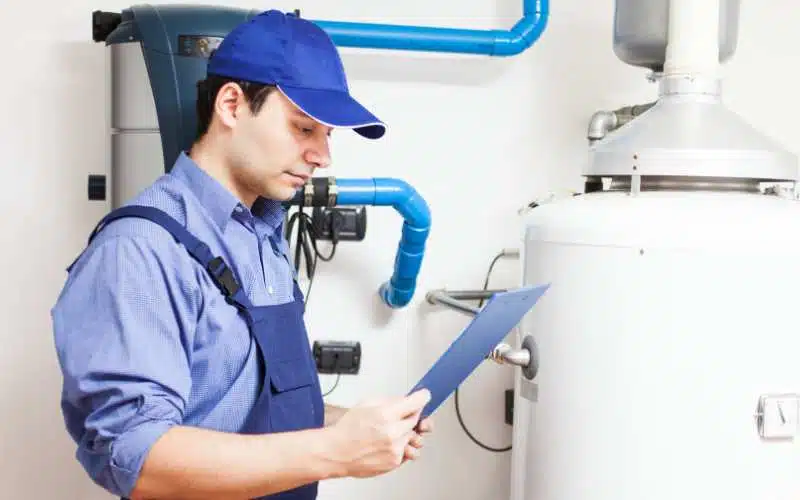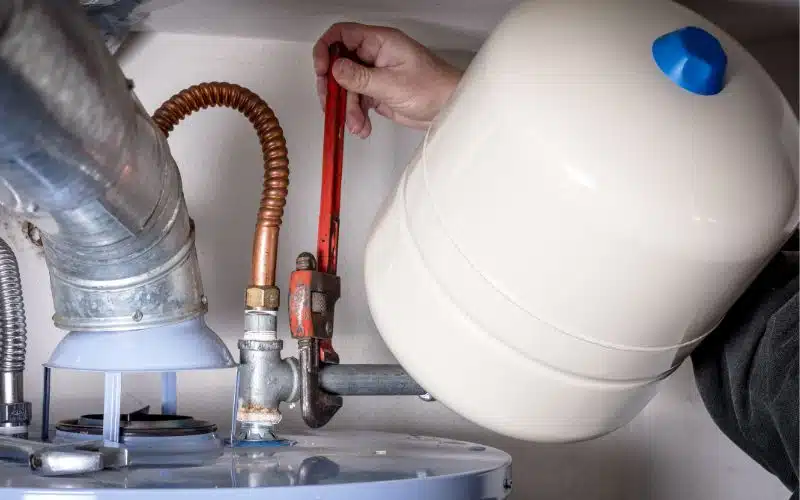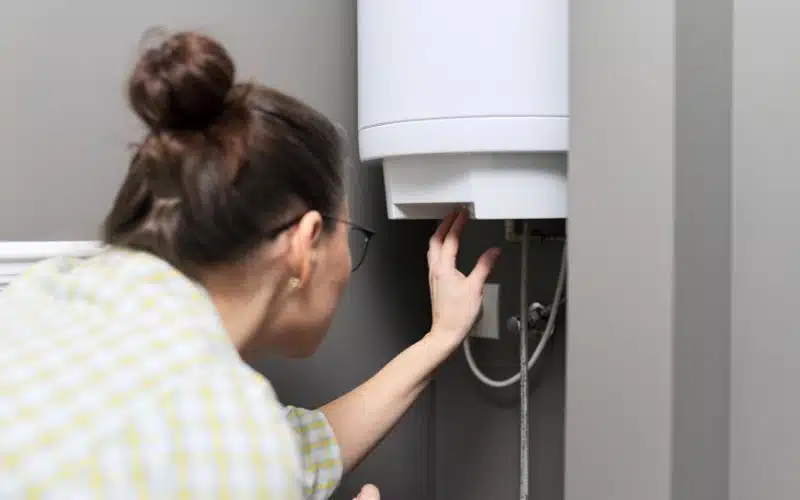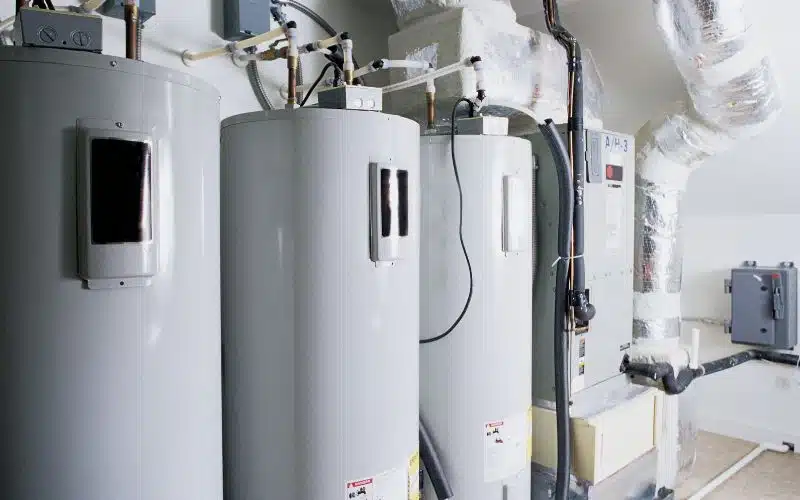HVAC systems are essential in adding comfort and quality to the indoor atmosphere of buildings.
They are a part of every residential and commercial building we need to use daily for comfort. HVAC systems are effective in both cool and hot temperatures.
However, HVAC systems also develop faults if something happens to any components or there is no adequate maintenance.
On the other hand, adequate maintenance and proper installation would boost the lifespan of the systems.
An HVAC system generally has an average lifespan of 15 to 25 years. However, factors like unsealed air leaks, insufficient insulation, and excessive airflow can shorten the lifespan of an HVAC system. Therefore, the system only lasts up to its expected lifespan if it does not encounter serious problems that may damage it.
How Far Away From the House Should My AC Condenser Be?

As a rule of thumb, an AC condenser should be at least two feet and at most three feet (24 to 36 inches) from the house.
Multiple air conditioners should be at least four feet apart in the exact location. If there are trees around the area, there should be at least a five feet (60 inches) distance between the trees above and the AC unit.
Furthermore, a minimum of three feet (36 inches) should be between the house and the side of the AC unit, where you have the fittings and controls.
The end of the condenser, which is also the service side, should be two feet (24 inches) away from the building.
Also, a split system AC condenser can be one foot (12 inches) from the wall of the house.
Additionally, the two feet rule applies to any building wall or fence. It gives your air conditioner compressor enough space for ventilation for optimum performance.
It would help to consider the wiring and pipes when installing an AC unit because they would affect the appliance’s efficiency.
Insufficient spacing may negatively affect your AC condenser and result in malfunction.
It is essential that the AC condenser positioning keeps it away from water, snow, and ice. These elements should not be able to fall on the AC unit from the roof.
There should be enough distance between the AC unit and various house parts. It is vital to know that the distance of the condenser varies for some sections of the house.
Here is the ideal distance for different house sections.
| House Sections | Distance of the AC Unit |
|---|---|
| All sides of the house | Two to three feet |
| Adjoining walls, building corners, and perimeters | A minimum of one and a half feet and a maximum of two feet |
| Fences and thick shrubs | Two feet |
| Leafy plants and the perimeters | Six inches due to adequate space for the plant to grow |
| Roof or deck | Eight feet from the highest point |
| Any Vents | Between four to eight feet |
In addition, it is vital to consider shrubs, trees, grasses, and potted plants when creating a distance between an AC condenser and the house.
They can disturb the AC unit’s ventilation and affect its efficiency. Therefore, it is best to trim plants and shrubs than outgrow past the regular two feet distance between the house and the AC condenser.
Finally, every type of building vent is a mechanical obstruction. It hinders the distance between the house and the AC condenser.
Although these vents may seem like normal wall parts, they can cause a fire if they are too close to an AC unit.
They produce gases that affect the rate of airflow of the AC unit. You need to create enough space between house vents and AC condensers.
How Far Can I Run My AC Line Set?
The distance of your AC line set depends on the rules of the zoning department in your location.
Generally, an AC line set would be less than 50 feet (600 inches) away from the building. It would increase the appliance efficiency and performance.
It would also help preserve your AC unit’s lifespan by keeping it at the optimal level.
Although there are no standard rules concerning the distance of the AC line set, it is ideal to consider areas with the noise ordinance.
Such areas may require a more extended line set distance because of the noise of the AC unit.
On the other hand, the noise of some old AC models could be loud and may be against the noise rule. Also, you must consider your neighbors in such cases and do what is suitable for everyone.
However, the manufacturer recommends that every air conditioner model has its unique installation distance.
The manufacturer states the minimum and maximum distance in the product information.
The installation distance may apply in the warranty of some AC models; hence you need to follow them strictly.
Some manufacturers may include equipment that would support your air conditioner’s performance.
Additionally, it is essential to know that the farther the AC line, the higher the installation and energy bill cost. A long AC line set would need more refrigerant, adding to the installation cost.
Also, a higher vertical flow due to a more extended line set would make your AC unit work harder, thereby increasing the unit’s energy consumption.
What is the Best Location for My Outdoor AC Unit?
The best location for an outdoor AC unit is one that gives the unit enough space to function correctly.
It must have enough ventilation to help it free enough heat from inside the house. The location must also be accessible if you need to repair or maintain your AC unit.
The space around the outdoor unit must be about two to three feet for proper ventilation.
Additionally, the location of your outdoor unit should have no obstruction within the open space surrounding it.
You should avoid putting the unit close to other heat sources. Also, you should avoid positioning the unit near outdoor furniture and doors, inside garages, and attics.
Many factors determine picking the best location for your outdoor AC unit.
The determining factors are;
#1. Shaded Area
It is ideal for installing your outdoor AC with enough shade to protect it from direct sunlight.
Heat would make your AC unit hotter and sense a higher temperature, thereby increasing the rate at which it operates.
In addition, a shade above the AC unit can help to reduce the struggle the appliance undergoes to work when the temperature is hotter.
Therefore the ideal location for your AC unit should be on the north or east section of the building where the radiation of the sunlight does not reach its peak.
The building would shade the AC unit when the sun reaches its peak. Also, you can install the AC unit under a tree shade so the tree can protect it from direct sunlight.
#2. Type of Tree
It is not ideal to surround your AC unit with deciduous trees. Tree shades should not shed so many leaves around the AC unit.
The leaves of the deciduous trees fall off their stems and gather around the AC during autumn.
The leaves may affect the AC’s coils and fans and reduce ventilation. It eventually affects the efficiency of the air conditioner and damages it.
It is best to clean leaf droppings around your AC unit regularly before they find a way into the system.
You can build a shade over the unit to protect it from sunlight and leaves. However, the shade should have its sides open because of adequate ventilation.
It is essential to check your AC constantly if there are many trees surrounding it.
#3. Installation Platform
It is best to position your AC unit on a grass platform. Grass would help to reduce the amount of heat that enters the unit.
However, it is essential to know that concrete and stone platforms absorb and radiate heat from the sun.
The heat increases the temperature around the unit and makes it work harder than its standard rate.
Alternatively, you can use mulch to cover the concrete and stone surfaces if there is no grass around your location.
#4. Protective Border
Building a protective border around your AC unit is vital because of water and mud splashes. It also protects the appliance from grass flying around during mowing.
Water, mud, and grass splashes can get into the AC unit and cause the coil to work higher than average, thereby increasing the unit’s energy consumption.
You can use a paver border or stone as the protective border.
#5. Away From Pets
It is crucial to install your outdoor AC units in a location that is not easily accessible to pets. Pets can chew off the electrical wiring or AC line insulation, damaging the air conditioner.
Chewing on electrical wirings can cause an electric shock to your pet. Also, if your pet urinates on the AC, it may get into the unit’s coil, increasing its operating rate and energy consumption.
Additionally, if you do not have a perfect location to keep your pets away from the AC unit, you can build a small fence or plant some shrubs around it.
The barrier would work effectively at keeping the animals away from the unit and protect against mud and loose soil particles entering the AC unit.
#6. AC Unit’s Height
It is crucial to place the unit on an elevated platform that can keep it away from water splashes during rainfall.
The platform should not be too high or low and should only be enough to protect the AC unit during rainfall.
Water could get into the unit’s coils if a flood results in damage or total breakdown. You must put the unit on a stable surface so the refrigerant can level adequately and function effectively.
#7. Outdoor Recreational Activities
You should position your outdoor AC unit away from where you usually carry out your recreational activities.
It is because air conditioning units can be a little noisy and may affect the quietness you need for your activities.
Although in recent times, new outdoor AC unit models do not make much noise like the old models.
What is the Safe Distance Between an Outdoor AC Unit and a Window?
The safe distance between an outdoor AC unit and a window is two feet (24 inches).
Just like the rule applies to the standard distance between an AC unit and a building, it also works effectively for a window.
However, it would be best to position it uniquely so it won’t affect the house’s air quality and cooling temperature.
Furthermore, it is ideal to position the AC unit so that the heat and air the unit releases don’t find their way back into the house.
Keep the position of the exhaust away from the entrance of the window. Heat and air from the exhaust would increase the house’s temperature and cause the AC unit to work harder.
Additionally, when the AC unit has to work harder for a long time, it reduces the room’s air quality.
At the same time, the unit finds it more challenging to reduce the house temperature. The AC unit would consume more energy and increase the cost of your energy bill.
It may eventually affect the functioning of the unit and damage it. Therefore, you mustn’t let the exhaust air and heat enter the room adjacent to the outdoor AC unit.
Also, it might contaminate the air quality of your room and cause serious health issues if you inhale it.
Another problem that may arise from inhaling the contaminated air in your room is respiratory illnesses. It can make you sneeze or even get worse.
The AC unit would also seem like it is not working enough if it can’t maintain a cool temperature.
You may have to spend more money on repairs if you do not change the direction of the air conditioner’s exhaust.
The air conditioner would keep overworking and experiencing issues that would demand constant repair.
Conclusion
In the end, it is essential to contact an expert before installing an AC unit in any location so you don’t go against any rules and codes.
In addition, measurements are an essential part of AC. installation; therefore, understand every section of your building and the appropriate measurements.





